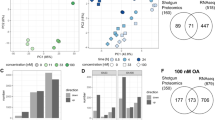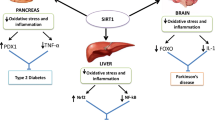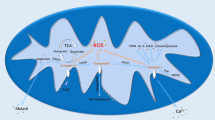Abstract
Selenium (Se) deficiency can affect the expression of microRNA (miRNA) and induce necroptosis, apoptosis, etc., resulting in damage to various tissues and organs. Bisphenol A (BPA) exposure can cause adverse consequences such as oxidative stress, endothelial dysfunction, and atherosclerosis. The toxic effects of combined treatment with Se-deficiency and BPA exposure may have a synergistic effect. We replicated the BPA exposure and Se-deficiency model in broiler to investigate whether the combined treatment of Se-deficiency and BPA exposure induced necroptosis and inflammation of chicken vascular tissue via the miR-26A-5p/ADAM17 axis. We found that Se deficiency and BPA exposure significantly inhibited the expression of miR-26a-5p and increased the expression of ADAM17, thereby increasing reactive oxygen species (ROS) production. Subsequently, we discovered that the tumor necrosis factor receptor (TNFR1), which was highly expressed, activated the necroptosis pathway through receptor-interacting protein kinase 1 (RIPK1), receptor-interacting protein kinase 3 (RIPK3), and mixed-lineage kinase domain-like (MLKL), and regulated the heat shock proteins-related genes expressions and inflammation-related genes expressions after exposure to BPA and selenium deficiency. In vitro, we found that miR-26a-5p knockdown and increased ADAM17 can induce necroptosis by activating the TNFR1 pathway. Similarly, both N-Acetyl-L-cysteine (NAC), Necrostatin-1 (Nec-1), and miR-26a-5p mimic prevented necroptosis and inflammation caused by BPA exposure and Se deficiency. These results suggest that BPA exposure activates the miR-26a-5p/ADAM17 axis and exacerbates Se deficient-induced necroptosis and inflammation through the TNFR1 pathway and excess ROS. This study lays a data foundation for future ecological and health risk assessments of nutrient deficiencies and environmental toxic pollution.
Access this article
We’re sorry, something doesn't seem to be working properly.
Please try refreshing the page. If that doesn't work, please contact support so we can address the problem.








Similar content being viewed by others
Data Availability
The raw data supporting the conclusions of this manuscript will be made available by the authors, without undue reservation, to any qualified researcher.
References
Yamazaki E, Yamashita N, Taniyasu S, Lam J, Lam PK, Moon HB et al (2015) Bisphenol A and other bisphenol analogues including BPS and BPF in surface water samples from Japan, China. Korea and India Ecotoxicol Environ Saf 122:565–572. https://doi.org/10.1016/j.ecoenv.2015.09.029
Yan Z, Liu Y, Yan K, Wu S, Han Z, Guo R et al (2017) Bisphenol analogues in surface water and sediment from the shallow Chinese freshwater lakes: occurrence, distribution, source apportionment, and ecological and human health risk. Chemosphere 184:318–328. https://doi.org/10.1016/j.chemosphere.2017.06.010
Friques AGF, Santos FDN, Angeli DB, Silva FAC, Dias AT, Aires R et al (2020) Bisphenol 4A contamination in infant rats: molecular, structural, and physiological cardiovascular changes and the protective role of kefir. J Nutr Biochem 75:108254. https://doi.org/10.1016/j.jnutbio.2019.108254
Jones DC, Miller GW (2008) The effects of environmental neurotoxicants on the dopaminergic system: a possible role in drug addiction. Biochem Pharmacol 76:569–581. https://doi.org/10.1016/j.bcp.2008.05.010
Ziv-Gal A, Flaws JA (2016) Evidence for bisphenol A-induced female infertility: a review (2007–2016). Fertil Steril 106:827–856. https://doi.org/10.1016/j.fertnstert.2016.06.027
Wan MLY, Co VA, El-Nezami H (2022) Endocrine disrupting chemicals and breast cancer: a systematic review of epidemiological studies. Crit Rev Food Sci Nutr 62:6549–6576
Frat L, Chertemps T, Pesce E, Bozzolan F, Dacher M, Planello R et al (2023) Impact of single and combined exposure to priority pollutants on gene expression and post-embryonic development in Drosophila melanogaster. Ecotoxicol Environ Saf. 250:114491. https://doi.org/10.1016/j.ecoenv.2022.114491
Azizidoost S, Nasrolahi A, Sheykhi-Sabzehpoush M, Akiash N, Assareh AR, Anbiyaee O et al (2023) Potential roles of endothelial cells-related non-coding RNAs in cardiovascular diseases. Pathol Res Pract. 242:154330. https://doi.org/10.1016/j.prp.2023.154330
Kong B, Qin Z, Ye Z, Yang X, Li L, Su Q (2019) microRNA-26a-5p affects myocardial injury induced by coronary microembolization by modulating HMGA1. J Cell Biochem 120:10756–10766. https://doi.org/10.1002/jcb.28367
Han G, Li H, Guo H, Yi C, Yu B, Lin Y et al (2022) The roles and mechanisms of miR-26 derived from exosomes of adipose-derived stem cells in the formation of carotid atherosclerotic plaque. Ann Transl Med 10:1134. https://doi.org/10.1134/10.21037/atm-22-4247
Yu X, Mao M, Liu X, Shen T, Li T, Yu H et al (2020) A cytosolic heat shock protein 90 and co-chaperone p23 complex activates RIPK3/MLKL during necroptosis of endothelial cells in acute respiratory distress syndrome. J Mol Med (Berl) 98:569–583. https://doi.org/10.1007/s00109-020-01886-y
Zhang W, Sun X, Lei Y, Liu X, Zhang Y, Wang Y et al (2023) Roles of selenoprotein K in oxidative stress and endoplasmic reticulum stress under selenium deficiency in chicken liver. Comp Biochem Physiol C Toxicol Pharmacol. 264:109504. https://doi.org/10.1016/j.cbpc.2022.109504
Kanazawa J, Kakisaka K, Suzuki Y, Yonezawa T, Abe H, Wang T et al (2022) Excess fructose enhances oleatic cytotoxicity via reactive oxygen species production and causes necroptosis in hepatocytes. J Nutr Biochem. 107:109052. https://doi.org/10.1016/j.jnutbio.2022.109052
Du Q, Yao H, Yao L, Zhang Z, Lei X, Xu S (2016) Selenium deficiency influences the expression of selenoproteins and inflammatory cytokines in chicken aorta vessels. Biol Trace Elem Res 173:501–513. https://doi.org/10.1007/s12011-016-0676-5
Pan T, Hu X, Liu T, Xu Z, Wan N, Zhang Y et al (2018) MiR-128-1-5p regulates tight junction induced by selenium deficiency via targeting cell adhesion molecule 1 in broilers vein endothelial cells. J Cell Physiol 233:8802–8814. https://doi.org/10.1002/jcp.26794
Miyazaki K, Watanabe C, Mori K, Yoshida K, Ohtsuka R (2005) The effects of gestational arsenic exposure and dietary selenium deficiency on selenium and selenoenzymes in maternal and fetal tissues in mice. Toxicology 208:357–365. https://doi.org/10.1016/j.tox.2004.11.030
Carmean CM, Mimoto M, Landeche M, Ruiz D, Chellan B, Zhao L et al (2021) Dietary selenium deficiency partially mimics the metabolic effects of arsenic. Nutrients 13. https://doi.org/10.3390/nu13082894
Zheng Y, Guan H, Yang J, Cai J, Liu Q, Zhang Z (2021) Calcium overload and reactive oxygen species accumulation induced by selenium deficiency promote autophagy in swine small intestine. Anim Nutr 7:997–1008. https://doi.org/10.1016/j.aninu.2021.05.005
Du Y, Xu T, Luo D, Wang Y, Yin H, Liu C et al (2023) Perfluorooctane sulfonate-induced apoptosis in kidney cells by triggering the NOX4/ROS/JNK axis and antagonism of cannabidiol. Environ Toxicol. https://doi.org/10.1002/tox.23794
Wang X, Xu T, Luo D, Li S, Tang X, Ding J et al (2023) Cannabidiol alleviates perfluorooctanesulfonic acid-induced cardiomyocyte apoptosis by maintaining mitochondrial dynamic balance and energy metabolic homeostasis. J Agric Food Chem 71:5450–5462. https://doi.org/10.1021/acs.jafc.2c08378
Lei Y, Zhang W, Gao M, Lin H (2023) Mechanism of evodiamine blocking Nrf2/MAPK pathway to inhibit apoptosis of grass carp hepatocytes induced by DEHP. Comp Biochem Physiol C Toxicol Pharmacol. 263:109506. https://doi.org/10.1016/j.cbpc.2022.109506
Cai J, Huang J, Yang J, Chen X, Zhang H, Zhu Y et al (2022) The protective effect of selenoprotein M on non-alcoholic fatty liver disease: the role of the AMPKα1-MFN2 pathway and Parkin mitophagy. Cell Mol Life Sci 79:354. https://doi.org/10.1007/s00018-022-04385-0
Chen L, Tao D, Qi M, Wang T, Jiang Z, Xu S (2022) Cineole alleviates the BPA-inhibited NETs formation by regulating the p38 pathway-mediated programmed cell death. Ecotoxicol Environ Saf. 237:113558. https://doi.org/10.1016/j.ecoenv.2022.113558
Zhang Y, Xu Y, Chen B, Zhao B, Gao XJ (2022) Selenium deficiency promotes oxidative stress-induced mastitis via activating the NF-κB and MAPK pathways in dairy cow. Biol Trace Elem Res 200:2716–2726. https://doi.org/10.1007/s12011-021-02882-0
Elswefy SE, Abdallah FR, Atteia HH, Wahba AS, Hasan RA (2016) Inflammation, oxidative stress and apoptosis cascade implications in bisphenol A-induced liver fibrosis in male rats. Int J Exp Pathol 97:369–379. https://doi.org/10.1111/iep.12207
Aboul Ezz HS, Khadrawy YA, Mourad IM (2015) The effect of bisphenol A on some oxidative stress parameters and acetylcholinesterase activity in the heart of male albino rats. Cytotechnology 67:145–155. https://doi.org/10.1007/s10616-013-9672-1
Hasuoka PE, Iglesias JP, Teves M, Kaplan MM, Ferrúa NH, Pacheco PH (2021) Selenomethionine administration decreases the oxidative stress induced by post mortem ischemia in the heart, liver and kidneys of rats. Biometals 34:831–840. https://doi.org/10.1007/s10534-021-00310-3
Piao X, Liu Z, Li Y, Yao D, Sun L, Wang B et al (2019) Investigation of the effect for bisphenol A on oxidative stress in human hepatocytes and its interaction with catalase. Spectrochim Acta A Mol Biomol Spectrosc. 221:117149. https://doi.org/10.1016/j.saa.2019.117149
Jung J, Kim Y, Na J, Qiao L, Bang J, Kwon D et al (2021) Constitutive oxidative stress by SEPHS1 deficiency induces endothelial cell dysfunction. Int J Mol Sci 22:11646. https://doi.org/10.3390/ijms222111646
Andersson H, Brittebo E (2012) Proangiogenic effects of environmentally relevant levels of bisphenol A in human primary endothelial cells. Arch Toxicol 86:465–474. https://doi.org/10.1007/s00204-011-0766-2
Siamwala JH, Dias PM, Majumder S, Joshi MK, Sinkar VP, Banerjee G et al (2013) L-theanine promotes nitric oxide production in endothelial cells through eNOS phosphorylation. J Nutr Biochem 24:595–605. https://doi.org/10.1016/j.jnutbio.2012.02.016
Easson S, Singh RD, Connors L, Scheidl T, Baker L, Jadli A et al (2022) Exploring oxidative stress and endothelial dysfunction as a mechanism linking bisphenol S exposure to vascular disease in human umbilical vein endothelial cells and a mouse model of postnatal exposure. Environ Int 170:107603. https://doi.org/10.1016/j.envint.2022.107603
Farah C, Michel LYM, Balligand JL (2018) Nitric oxide signalling in cardiovascular health and disease. Nat Rev Cardiol 15:292–316. https://doi.org/10.1038/nrcardio.2017.224
Mohsenzadeh MS, Razavi BM, Imenshahidi M, Mohajeri SA, Rameshrad M, Hosseinzadeh H (2021) Evaluation of green tea extract and epigallocatechin gallate effects on bisphenol A-induced vascular toxicity in isolated rat aorta and cytotoxicity in human umbilical vein endothelial cells. Phytother Res 35:996–1009. https://doi.org/10.1002/ptr.6861
Reventun P, Sanchez-Esteban S, Cook A, Cuadrado I, Roza C, Moreno-Gomez-Toledano R et al (2020) Bisphenol A induces coronary endothelial cell necroptosis by activating RIP3/CamKII dependent pathway. Sci Rep 10:4190. https://doi.org/10.1038/s41598-020-61014-1
Liu J, Chen T, Wang S, Wu H, Xu S (2022) BPA exposure aggravates necroptosis of myocardial tissue in selenium deficient broilers through NO-dependent endoplasmic reticulum stress. Toxicology. 472:153190. https://doi.org/10.1016/j.tox.2022.153190
Cui J, Liu H, Xu S (2020) Selenium-deficient diet induces necroptosis in the pig brain by activating TNFR1 via mir-29a-3p. Metallomics 12:1290–1301. https://doi.org/10.1039/d0mt00032a
Qin D, Wang X, Li Y, Yang L, Wang R, Peng J et al (2016) MicroRNA-223-5p and -3p cooperatively suppress necroptosis in ischemic/reperfused hearts. J Biol Chem 291:20247–20259. https://doi.org/10.1074/jbc.M116.732735
Yu Y, Chen M, Guo Q, Shen L, Liu X, Pan J et al (2023) Human umbilical cord mesenchymal stem cell exosome-derived miR-874-3p targeting RIPK1/PGAM5 attenuates kidney tubular epithelial cell damage. Cell Mol Biol Lett 28:12. https://doi.org/10.1186/s11658-023-00425-0
Dou X, Yu X, Du S, Han Y, Li L, Zhang H et al (2022) Interferon-mediated repression of miR-324–5p potentiates necroptosis to facilitate antiviral defense. EMBO Rep. 23:e54438. https://doi.org/10.15252/embr.202154438
Bolik J, Krause F, Stevanovic M, Gandraß M, Thomsen I, Schacht SS et al (2022) Inhibition of ADAM17 impairs endothelial cell necroptosis and blocks metastasis. J Exp Med 219:e20201039. https://doi.org/10.1084/jem.20201039
Cao C, Chen S, Song Z, Liu Z, Zhang M, Ma Z, et al. (2022) Inflammatory stimulation mediates nucleus pulposus cell necroptosis through mitochondrial function disfunction and oxidative stress pathway. Front Biosci (Landmark Ed). 27:111. https://doi.org/10.31083/j.fbl2704111
Xue F, Cheng J, Liu Y, Cheng C, Zhang M, Sui W et al (2022) Cardiomyocyte-specific knockout of ADAM17 ameliorates left ventricular remodeling and function in diabetic cardiomyopathy of mice. Signal Transduct Target Ther 7:259. https://doi.org/10.1038/s41392-022-01054-3
Mázló A, Jenei V, Burai S, Molnár T, Bácsi A, Koncz G (2022) Types of necroinflammation, the effect of cell death modalities on sterile inflammation. Cell Death Dis 13:423. https://doi.org/10.1038/s41419-022-04883-w
Xu T, Liu Q, Chen D, Liu Y (2022) Atrazine exposure induces necroptosis through the P450/ROS pathway and causes inflammation in the gill of common carp (Cyprinus carpioL.). Fish Shellfish Immunol 131:809–816. https://doi.org/10.1016/j.fsi.2022.10.022
Carper SW, Duffy JJ, Gerner EW (1987) Heat shock proteins in thermotolerance and other cellular processes. Cancer Res 47:5249–5255
Sidera K, Patsavoudi E (2014) HSP90 inhibitors: current development and potential in cancer therapy. Recent Pat Anticancer Drug Discov 9:1–20
Zhao XM, Chen Z, Zhao JB, Zhang PP, Pu YF, Jiang SH et al (2016) Hsp90 modulates the stability of MLKL and is required for TNF-induced necroptosis. Cell Death Dis 7:e2089. https://doi.org/10.1038/cddis.2015.390
Marunouchi T, Nishiumi C, Iinuma S, Yano E, Tanonaka K (2021) Effects of Hsp90 inhibitor on the RIP1-RIP3-MLKL pathway during the development of heart failure in mice. Eur J Pharmacol 898:173987. https://doi.org/10.1016/j.ejphar.2021.173987
Xue Y, Wang H, Tian B, Wang S, Gao XJ (2023) Selenium deficiency promotes the expression of LncRNA-MORC3, activating NLRP3-caspase-1/IL-1β signaling to induce inflammatory damage and disrupt tight junctions in piglets. Biol Trace Elem Res 201:2365–2376. https://doi.org/10.1007/s12011-022-03341-0
Billack B, Heck DE, Mariano TM, Gardner CR, Sur R, Laskin DL et al (2002) Induction of cyclooxygenase-2 by heat shock protein 60 in macrophages and endothelial cells. Am J Physiol Cell Physiol 283:C1267-1277. https://doi.org/10.1152/ajpcell.00609.2001
Khoso PA, Liu C, Liu C, Khoso MH, Li S (2016) Selenium deficiency activates heat shock protein expression in chicken spleen and thymus. Biol Trace Elem Res 173:492–500. https://doi.org/10.1007/s12011-016-0673-8
Kipp AP, Banning A, van Schothorst EM, Méplan C, Coort SL, Evelo CT et al (2012) Marginal selenium deficiency down-regulates inflammation-related genes in splenic leukocytes of the mouse. J Nutr Biochem 23:1170–1177. https://doi.org/10.1016/j.jnutbio.2011.06.011
Gu X, Wang Y, He Y, Zhao B, Zhang Q, Li S (2022) MiR-1656 targets GPX4 to trigger pyroptosis in broilers kidney tissues by activating NLRP3 inflammasome under Se deficiency. J Nutr Biochem. 105:109001. https://doi.org/10.1016/j.jnutbio.2022.109001
Migliaccio S, Bimonte VM, Besharat ZM, Sabato C, Lenzi A, Crescioli C et al (2021) Environmental contaminants acting as endocrine disruptors modulate atherogenic processes: new risk factors for cardiovascular diseases in women? Biomolecules 12:44. https://doi.org/10.3390/biom12010044
Acknowledgements
The authors thank the Key Laboratory of the Provincial Education Department of Heilongjiang for Common Animal Disease Prevention and Treatment, College of Veterinary Medicine, Northeast Agricultural University for providing conditions.
Funding
This work was supported by the Natural Science Foundation of Heilongjiang Province (ZD2022C005) and the National Natural Science Foundation (Grant No. 32072811).
Author information
Authors and Affiliations
Contributions
All authors contributed to the study conception and design. Material preparation, data collection, and analysis were performed by Xue Fan, Yixuan Wang, and Jintao Zhang. Supervision and software were performed by Hongjin Lin. Reviewing, editing, and funding acquisition were performed by Zhikun Bai and Shu Li. The first draft of the manuscript was written by Xue Fan, and all authors commented on previous versions of the manuscript. All authors read and approved the final manuscript.
Corresponding authors
Ethics declarations
Ethics Approval
All procedures used in this study were approved by the Institutional Animal Care and Use Committee (NEAUEC20200311) of Northeast Agricultural University.
Conflict of Interest
The authors declare no competing interests.
Additional information
Publisher's Note
Springer Nature remains neutral with regard to jurisdictional claims in published maps and institutional affiliations.
Rights and permissions
Springer Nature or its licensor (e.g. a society or other partner) holds exclusive rights to this article under a publishing agreement with the author(s) or other rightsholder(s); author self-archiving of the accepted manuscript version of this article is solely governed by the terms of such publishing agreement and applicable law.
About this article
Cite this article
Fan, X., Wang, Y., Zhang, J. et al. Bisphenol A Regulates the TNFR1 Pathway and Excessive ROS Mediated by miR-26a-5p/ADAM17 Axis to Aggravate Selenium Deficiency-Induced Necroptosis in Broiler Veins. Biol Trace Elem Res 202, 1722–1740 (2024). https://doi.org/10.1007/s12011-023-03756-3
Received:
Accepted:
Published:
Issue Date:
DOI: https://doi.org/10.1007/s12011-023-03756-3




